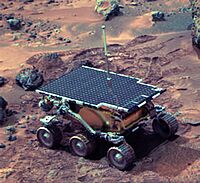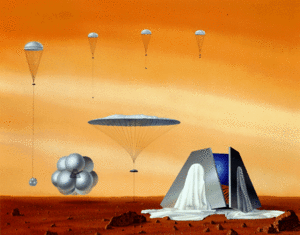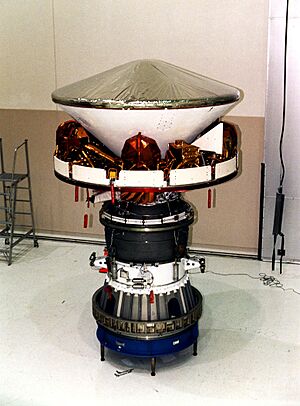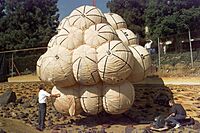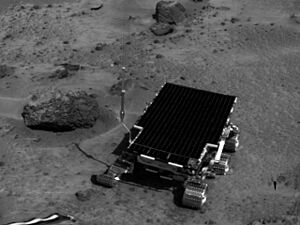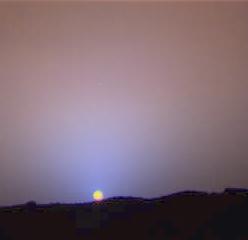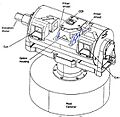Mars Pathfinder facts for kids
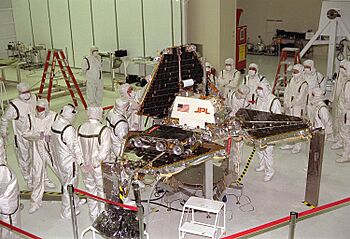
Pathfinder and Sojourner at JPL in October 1996, being 'folded' into its launch position.
|
|
| Mission type | Lander · Rover |
|---|---|
| Operator | NASA · Jet Propulsion Laboratory |
| Mission duration | 85 days Launch to last contact: 9 months, 23 days |
| Spacecraft properties | |
| Launch mass | 890 kg (includes propellant) |
| Power | Pathfinder: 35 W Sojourner: 13 W |
| Start of mission | |
| Launch date | December 4, 1996 06:58:07 UTC |
| Rocket | Delta II 7925 (#D240) |
| Launch site | Cape Canaveral SLC-17 |
| Contractor | None |
| End of mission | |
| Last contact | September 27, 1997 10:23 UTC |
| Mars lander | |
| Landing date | July 4, 1997 16:56:55 UTC MSD 43905 04:41 AMT |
| Landing site | Ares Vallis, Chryse Planitia, Mars 19°7′48″N 33°13′12″W / 19.13000°N 33.22000°W |
 Official insignia of the Mars Pathfinder mission. |
|
The Mars Pathfinder was a cool robotic spacecraft from America. It landed on Mars in 1997, carrying a base station and a small, wheeled robot called Sojourner. This mission was super important because Sojourner was the first-ever rover to explore another planet!
The mission launched on December 4, 1996, thanks to NASA and a Delta II rocket. It arrived on Mars on July 4, 1997, landing in a rocky area called Ares Vallis. Once the lander opened up, Sojourner rolled out to begin its exciting work. The mission's main goal was to study Mars's atmosphere, climate, and geology. It also looked at the different rocks and soil on the planet.
Mars Pathfinder was part of NASA's Discovery Program. This program focuses on sending spacecraft that are "cheaper, faster, and better." The mission was managed by the Jet Propulsion Laboratory (JPL). It was the first successful Mars lander since the Viking missions in 1976. It also helped test new technologies like special airbags for landing and ways for rovers to avoid obstacles.
Contents
- Why was Mars Pathfinder sent to Mars?
- What scientific tools did Pathfinder use?
- How did the Pathfinder lander work?
- What did the Sojourner rover do?
- Where did Pathfinder land?
- How did Pathfinder land on Mars?
- What did Sojourner discover on Mars?
- Sojourner's rock analysis
- How did the computers work?
- What did Pathfinder teach us?
- When did the mission end?
- How was the Sojourner rover named?
- Honors for the Mission
- Images for kids
- See also
Why was Mars Pathfinder sent to Mars?
The Mars Pathfinder mission had several important goals:
- To show that NASA could build "faster, better, and cheaper" spacecraft. The lander was developed in just three years and cost less than $150 million. The rover cost $25 million.
- To prove that a simple system could send scientific tools to another planet. This mission cost much less than the older Viking missions.
- To demonstrate NASA's commitment to exploring planets without spending huge amounts of money. The total cost, including launch and operations, was $280 million.
What scientific tools did Pathfinder use?
The Mars Pathfinder mission used three main scientific tools to study Mars.
- The lander had a special camera called the Imager for Mars Pathfinder (IMP). This camera could take 3D pictures and had filters to study the surface and atmosphere. It also included a magnetometer and anemometer to measure magnetic fields and wind.
- The lander also had the Atmospheric Structure Instrument/Meteorology Package (ASI/MET). This acted like a weather station on Mars. It collected data on pressure, temperature, and wind speeds. It even had three windsocks to measure wind direction.
The Sojourner rover carried its own set of tools:
- An Alpha Proton X-ray Spectrometer (APXS). This tool was used to figure out what elements rocks and soil were made of.
- Three cameras: two black-and-white cameras for navigation and one color camera. These cameras helped scientists see the Martian surface up close.
- A laser system to help the rover avoid obstacles.
These tools helped scientists learn about the geology of Mars, the types of rocks and soil, and even the planet's atmosphere and how it spins.
How did the Pathfinder lander work?
The IMP camera on the Pathfinder lander had two "eyes" to take 3D images. It also had different filters to capture specific details of the Martian surface and atmosphere.
The ASI/MET sensors on the lander recorded weather data. They measured temperature, pressure, and wind during the spacecraft's journey through the atmosphere and after it landed.
What did the Sojourner rover do?
The Sojourner rover was a small, tough robot. It had:
- Three cameras (two black-and-white, one color) to take pictures.
- A laser system to detect hazards and help it move around safely.
- An Alpha Proton X-ray Spectrometer (APXS) to analyze rocks and soil.
- Experiments to study how its wheels wore down and how dust stuck to materials.
- Accelerometers to measure its movement.
Where did Pathfinder land?
The landing spot was an ancient flood plain in Mars's northern part called "Ares Vallis". This area is very rocky. Scientists chose it because it seemed safe to land on and had many different kinds of rocks. These rocks were likely left behind by a huge flood long ago.
After the successful landing, the lander was renamed the Carl Sagan Memorial Station. This was done to honor the famous astronomer Carl Sagan.
How did Pathfinder land on Mars?
Mars Pathfinder used a very clever way to land on Mars. It involved several steps:
- First, it entered the Martian atmosphere inside a protective capsule called an aeroshell. This shell helped it slow down from a super-fast speed of about 6.1 kilometers per second (13,600 mph).
- Then, a huge supersonic parachute opened up. This slowed the spacecraft down even more.
- Next, the heat shield was dropped, and the lander was lowered from the backshell on a long cable.
- When it was about 98 meters (320 feet) above the ground, small rockets fired to slow it down almost to a stop.
- Finally, giant airbags inflated around the lander in less than a second. These airbags were like huge cushions.
The lander then cut loose from the rockets and fell to the ground, bouncing many times. The airbags protected it from the impact. The whole landing process took only four minutes!
Once the lander stopped bouncing, the airbags deflated. The lander then opened its "petals," which held the Sojourner rover and solar panels. The landing happened at night on Mars, so the lander waited until sunrise to send its first pictures and signals back to Earth.
On the first Martian day (called Sol 1), engineers noticed one airbag hadn't fully deflated. This could block the rover's path. They sent commands from Earth to fix it, and it worked! On Sol 2, Sojourner rolled off the lander and began its exploration.
What did Sojourner discover on Mars?
The Sojourner rover left the lander on its second day on Mars. It drove towards rocks that scientists named after cartoon characters, like "Barnacle Bill", "Yogi", and "Scooby-Doo". The rover used its tools to study what these rocks and the soil were made of. Meanwhile, the lander took pictures and observed the weather.
Sojourner was about 65 centimeters (25 inches) long and weighed about 10.5 kilograms (23 pounds). It moved very slowly, about 1 centimeter per second. In total, it traveled about 100 meters (330 feet) and never went further than 12 meters (39 feet) from the lander. During its 83 days of operation, it sent 550 photos and analyzed 16 different spots.
Sojourner's rock analysis
One of the first rocks Sojourner analyzed was "Barnacle Bill." The APXS tool took ten hours to scan it. It found almost all elements except hydrogen. The results showed that "Barnacle Bill" was similar to rocks on Earth called andesites. This suggests that Mars had volcanic activity in the past. Andesite rocks form when magma changes over time, showing that Martian rocks have been melted and changed.
Another rock, "Yogi," was found to be a basaltic rock, which is more basic than andesite. Its shape suggested it might have been moved there by a flood. Scientists also found a rock named "Moe" with marks that showed wind erosion. Most rocks had a lot of silicon. Sojourner also found crescent-shaped sand dunes, similar to those on Earth.
How did the computers work?
The Sojourner rover had a small computer with a 2 MHz Intel 80C85 CPU. It had 512 KB of RAM and 176 KB of flash memory for storage.
The Pathfinder lander had a more powerful computer. It used a special Radiation Hardened IBM Risc 6000 CPU. This computer had 128 MB of RAM and 6 MB of storage. Its operating system was called VxWorks.
During the mission, the lander's computer had a software problem that caused it to reset sometimes. Scientists on Earth were able to fix this problem by sending new instructions to the computer. This was a great example of how engineers can solve problems on spacecraft millions of miles away!
What did Pathfinder teach us?
The Pathfinder lander sent back a huge amount of information. It sent over 2.3 billion bits of data, including 16,500 pictures! It also made 8.5 million measurements of the Martian atmosphere.
Scientists learned that the tiny particles in the pink haze of the Martian sky were about one micrometer in size. The color of some soils suggested that Mars might have had a warmer and wetter climate in the past. Pathfinder also had magnets to study the magnetic dust. Most magnets collected dust, showing that the airborne dust was magnetic.
By tracking the lander's signals, scientists also learned more about Mars's inside. They found that the planet's central metallic core is between 1,300 and 2,000 kilometers (800 and 1,200 miles) wide.
When did the mission end?

The Mars Pathfinder mission was planned to last for about a month. However, the rover kept working successfully for almost three months! Communication with Pathfinder stopped on October 7, 1997. The last data was received on September 27, 1997. Mission managers tried for five more months to get it working again, but they couldn't. The mission officially ended on March 10, 1998.
One reason for the mission ending might have been the battery. It was designed to last for one month. After being charged and discharged many times, it might have failed. Without the battery, the electronics couldn't stay warm enough during the cold Martian nights, causing parts to break. Even so, the mission had already achieved all its goals and more!
Years later, in January 2007, the Mars Reconnaissance Orbiter spacecraft spotted the Pathfinder lander on Mars from space!
How was the Sojourner rover named?
The name Sojourner was chosen through a worldwide competition for students. Valerie Ambroise, a 12-year-old from Connecticut, won the contest. Students were asked to pick a historical heroine and write an essay about her achievements. They also had to explain how a rover named after her would show those achievements on Mars.
Valerie's winning essay suggested naming the rover after Sojourner Truth. She was a famous women's rights activist from the 1800s. Other popular names suggested included explorer Sacajewea and aviator Amelia Earhart.
Honors for the Mission
- In 1997, the Sojourner Team received a special award for their excellent technical work.
- On October 21, 1997, Sojourner was made an honorary member of the Planetary Geology Division of the Geological Society of America.
- In 2003, Sojourner was added to the Robot Hall of Fame.
Images for kids
-
Wheel size comparison: Sojourner, Mars Exploration Rover, Mars Science Laboratory
See also
- Exploration of Mars
- Life on Mars
- List of missions to Mars
- Mars Exploration Rover
- Mars Science Laboratory
- Mars 2020
- Comparison of embedded computer systems on board the Mars rovers


